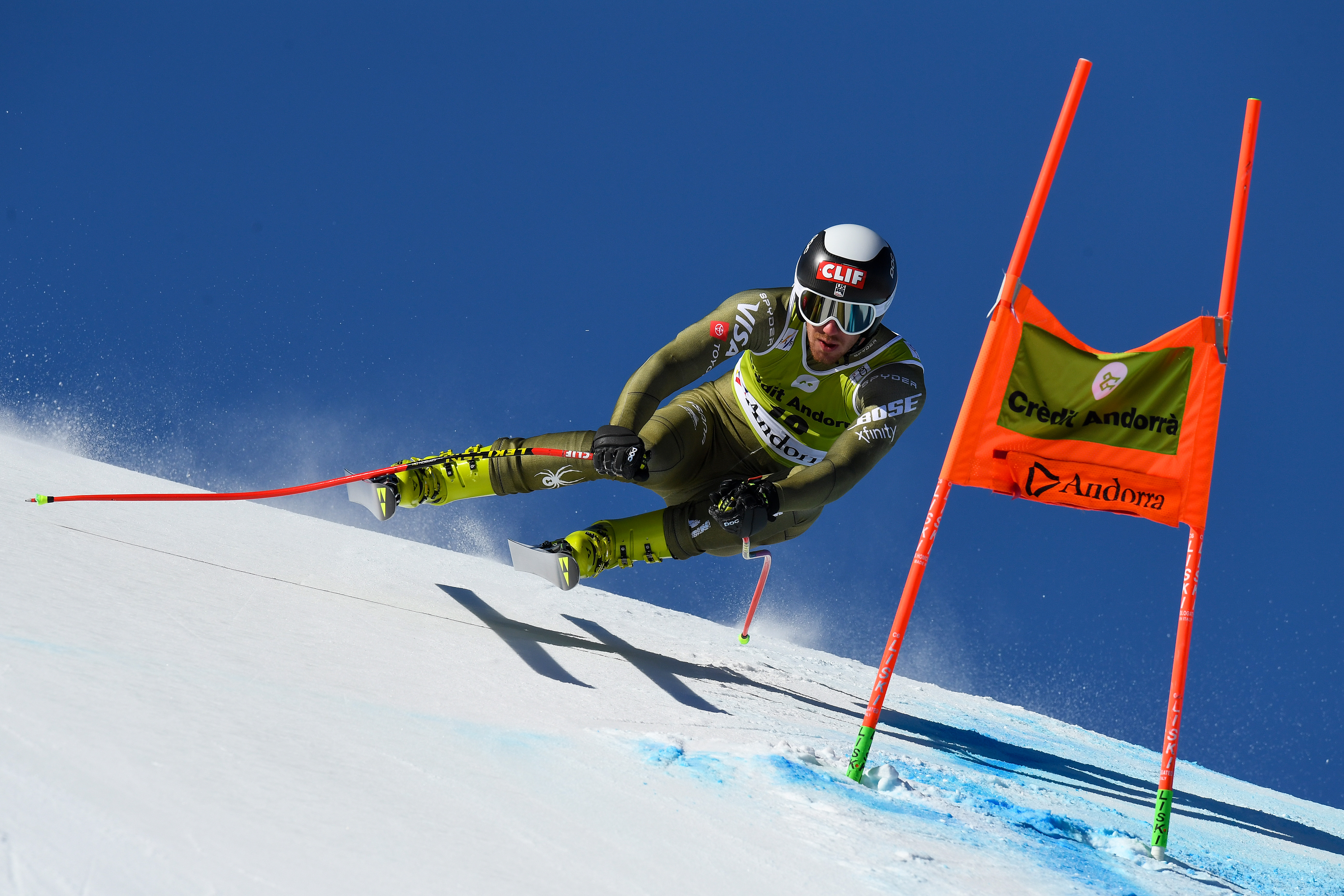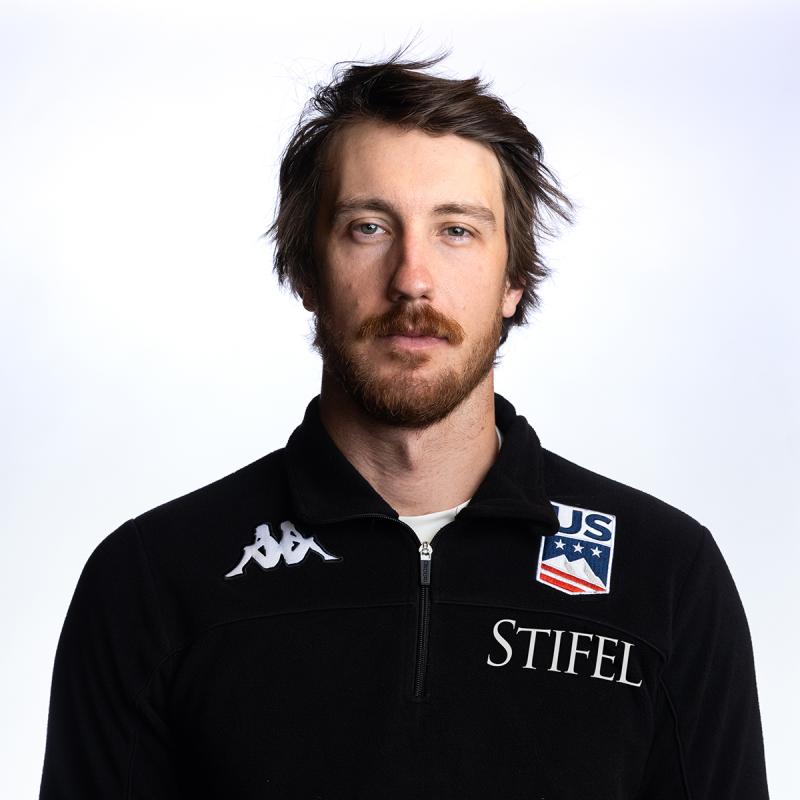Bennett - Downhill is More Like Fishing Than You’d Think

Downhiller Bryce Bennett (Squaw Valley, Calif.) is an unusual human - in the best sense of the word. First of all, at 6-foot-7-inches, he towers over his competitors. Second of all, he’s truly a good human to the core. Bennett takes a no drama approach to skiing, and has proven that he’s one of the best in the world in downhill. With a men’s downhill field that’s deep and talented, that’s no easy feat - and Bennett is on the cusp of greatness, ranked sixth in the world going into FIS Ski World Cup Finals in Soldeu-El Tarter, Andorra.
After catapulting from bib 57th to land in sixth in Val Gardena in 2015, then seeing numerous strong results on that track the next few years, everything seemed to click in 2018-19 and Bennett has proven he's not a one track pony. With seven starts and seven top-15 finishes, four top-10 and three top-five finishes this season, Bennett has shown consistency and strength. And the other guys are watching. Beyond that, the world is paying attention too.
Alpine Communications Manager Megan Harrod sat down with Bennett prior to Wednesday’s downhill to talk shop. Grab a coffee and stay for a bit, as we delve into the mind of a giant...
Megan Harrod: Let’s talk about Andorra first. This is your first time here. It’s always tricky with downhill, as experience with a track benefits racers. How do you feel about this track?
Bryce Bennett: This track is easy, but that’s where it’s the most difficult for me. It’s difficult, too, because we’ve been on the road for two and a half months and it just wears you down. We’ve been constantly traveling, I’ve been sick a few times, and at this point it’s easy to have one foot on the plane. With the track being simple, one mistake and you’re not going to be that fast, so that makes it difficult.”
MH: So, most training runs this year, you’ve had difficulty…
(at this point of the conversation, Bennett interrupts me and says, “Yeah, I’ve sucked a**!”)
MH: What’s the difference between training days and race days for you, are you testing stuff out on training days, or are you just a total race horse on race day when it’s go time?
BB: I think it’s a combination of both. I mean, like, winning a training run is like kissing your sister - like it feels sweet, but you’re kissing your sister. If you put 100 percent risk out there on training days, like - why?! - you know, so you test out those few sections and you figure out what sections you’re skiing well and you don’t really need to put that much effort or thought into, and then you work on the sections that are giving you trouble or you’re losing time. Then on race day - pretty much everyone is going to be on the same line - everywhere. There are a few variances, but it’s all about who can execute that line on race day. In particular, this season, all of the other pieces of the puzzle are in check - my equipment, where I’m at physically, mentally, how I’m managing my energy...so on race day, I have confidence in that. And I have confidence in the line that I’m skiing, and there’s no second guessing anything so I can just commit to that.
MH: How much of that is the confidence you have in your set-up and your team, with serviceman Leo Mussi and veteran teammate and mentor Steven Nyman (Sundance, Utah)?
BB: Gaining the experience through the years on these tracks, where when you show up to the venue you already have a game plan of what you’re doing...and then you just go through the weekend and you kind of refine that. It’s also nice having someone like Steven, because we’re able to communicate pretty similarly on skiing, and so we can break things down together, which has been really nice. And also, with Leo - it’s like, I know every time I put race skis on my feet that they’re not going to be slow. That’s a good feeling to have. And the boots are working - they’re getting a bit worn out right now - I’m lacking a little confidence in that area, but I’ve just got literally one more run to put something together. So, that’s what we’re going to go and do.
MH: You’re likely not paying attention to it, but the last time we had a downhiller in the top five was Bode Miller in 2012, and top six was Nyman in 2015 and 2016. You’re not far away from that, and it’s something you could very well achieve. What was the biggest change for you from last year, when you were ranked 20th in the world in downhill? How did you create that plan and then commit to it?
BB: This plan, I mean, it’s been literally four years in the making. And that’s the side not even the coaching staff sees, or the serviceman sees, it’s like what you’re doing behind closed doors and in your own head...and formulating a plan of all of the different pieces of the sport, breaking them down and actually understanding them for what they are, and then implementing a plan so you can check some of those boxes as far as: 1) my boots are set up right and I have the right plastic, and they’re canted the right way, 2) my base bevels are right, 3) my binding position, 4) the ski models are right, 5) I’m doing the right things in the off season for my physical training, 6) the mental preparation is spot on, etc. And also, like, in order to go fast, you need to build strong turns, and have great aerodynamics, and the list can go on and on. It’s like strength and weakness - am I good at a certain skill...yes or no? No? Ok, well then how am I going to work on it, and how am I going to put it together in a plan through the offseason that I could give myself time to work on it, and make it a habit?
So, it’s just been building. During training this summer, I was literally two seconds out every single training run...like getting “chick'd”, but it didn’t really affect me because I knew what I was doing in my skiing and I didn’t care that the intensity wasn’t there. I looked at it and thought, ‘If I’m sick and my dog died at home, and I’m having a terrible day, my skiing is still going to be solid. It’s a habit.’ So that’s what I’ve been really trying to work on. The flip side is now you’re in a position of doing well, and the expectations of doing well, start to weigh on you. I’d say I do a pretty good job of getting rid of that.
MH: So, when you get a top-15 now, which is still super solid, everyone else might react to it a bit differently because they’re thinking, ‘Well, he’s on the cusp of podiuming...he’s so close!’ But you know - on any given day - the guy who gets first can get 25th the next day.
BB: Yeah, for sure. I could be telling you all of this now, and then next year come out and get 31st every single World Cup and say, ‘Yeah, I thought I had something figured out but obviously I don’t understand this at all. And then you’re back to the drawing board. But I feel like I’ve implemented this plan and it’s just like every year, at the end of the season, going back and reevaluating what worked throughout the season, and then making adjustments. At this point, it’s just fine tuning of how I structure and manage the energy and my physical preparedness, and what I need to do for races to become faster. When I first started racing World Cup, I powered up the turn like 10 percent of the time. So, if you want to be a guy who wins World Cups, you power up the turn 90 percent of the time. If you want to be on the podium to top five, you’ve got to do it 80 percent of the time. So, it just keeps going down and trickling down. So, first I think, ‘How do I power up the ski in incredibly gnarly situations where it’s super bumpy, it’s dark and it’s high speed, and how can I do that consistently?’ So it’s fine tuning that.
MH: Ok, if you’re looking at your summer last year, and you’re struggling mentally because criteria for A-team changed from top 25 to top 15 and you missed that. What is the motivator for you to come back? Is it figuring out how to fine tune those elements?
BB: Yeah, I mean, this is crazy - but I relate it to fishing a lot. People think you go out and just cast a line, but to be someone who really understands the habits of fish and what they’re doing throughout their life and throughout these different water systems, is the same thing - just breaking down and understanding the process. So, that’s what motivates me. Then, on race day, I’m in a space where I’ve done the homework and I can ski free. Race day has been pretty fun for me, to ski that way. But, the only unfortunate part is that - of 365 days in the year - you get, what, 15 minutes of racing?! A lot of the time, it’s like, not that much fun.
MH: You’ve gotta find the joy in training too…
BB: Yeah, and a lot of times I don’t find the joy in training because I come down and I’m like, “Shi*t.” I feel like the odd man out, where I’m just so slow in training every time. I’m just this weird guy that’s focusing on this one thing, and I’ve been focusing on the same thing for two years every single day of my skiing. Every run. Every turn. And, it kind of gets boring. But, the process of seeing it unfold is what is gratifying. To know that I came up with this plan myself - you know - I wanted it to be like, if I failed, it’s on me. Accountability is huge for me. Yes, I take input from my coaches, and utilize that input, but for the most part - no one is telling me what to do.
MH: Well, ultimately, like you’ve said before, it’s just you and the mountain. I think your coach Konrad Rickenbach, at Squaw Valley, said if he dropped you into the middle of the forest, how would you get out?
BB: Yeah, what are you going to do? Are you going to wait for the coach to save you or are you going to get out of there on your own?
Tune in to the men’s downhill on Wednesday on the Olympic Channel to see if Bennett will take the leap and make it into the top five.
STANDINGS
Men’s downhill
HOW TO WATCH
All times EST
*Same-day broadcast
**Next-day broadcast
Wednesday, March 13
5:30 a.m. - Men and women’s World Cup Finals downhill - Soldeu, AND - Olympic Channel-TV, OlympicChannel.com & NBC Sports Gold
12:30 p.m. - Men and women’s World Cup Finals downhill - Soldeu, AND - NBCSN*

